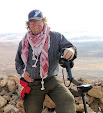
At Makin's Fort the Hijaz railway crosses a highly vulnerable ten arch viaduct over a wadi. This point is guarded by a fort with a loopholed block house in the centre and a strong perimeter wall and bank around the outside. A further block house and observation posts provide outlying defence.
The team planned the fort, drew the standing buildings, metal detected the site and cleared areas of the buildings in order to recover artifacts.
We found two more examples of what we believe are the tips of the legs of heliographs. A small iron tapered ferrule fits on to a fine wooden rod, and this would have been one of three forming a tripod. These devices used sunlight to transmit messages in code between military positions. This would have been an ideal method of communication in the desert for a relatively low tech army which lacked the telephones and even primitive wireless that were in use on some other fronts.
Elsewhere a lone detectorist accompanied the field walking team to quickly sweep three smaller forts situated either side of Makin's. Metallic finds of any type, including modern or rusty metal, were low in number, although there were a few Ottoman army buttons at the one North of the main area of work today. Were these simply rarely used? This would be odd in the context of their structure.
The phosphate trains rumbled by on the new line as we continued our exploration of this fascinating and puzzling landscape.













No comments:
Post a Comment